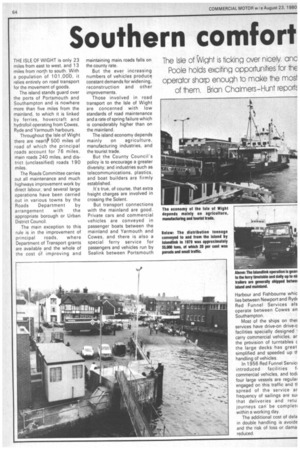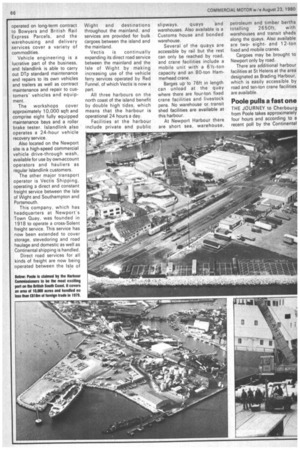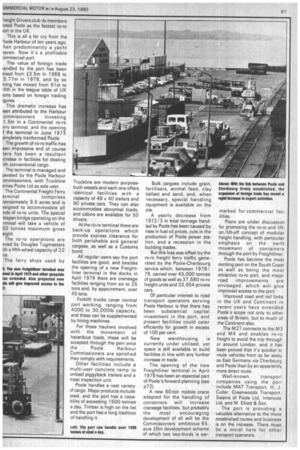Southern comfort
Page 66

Page 67

Page 68

Page 69

If you've noticed an error in this article please click here to report it so we can fix it.
THE ISLE OF WIGHT is only 23 miles from east to west, and 13 miles from north to south. With a population of 101,000, it relies entirely on road transport for the movement of goods.
The island stands guard over the ports of Portsmouth and Southampton and is nowhere more than five miles from the mainland, to which it is linked by ferries, hovercraft and hydrofoil operating from Cowes, Ryde and Yarmouth harbours.
Throughout the Isle of Wight there are near'? 500 miles of road of which the principal roads account for 76 miles, main roads 240 miles. and district (unclassified) roads 190 miles.
The Roads Committee carries out all maintenance and much highways improvement work by direct labour, and several large operations have been carried out in various towns by the Roads Department by arrangement with the appropriate borough or Urban District Council.
The main exception to this rule is in the improvement of principal roads, where Department of Transport grants are available and the whole of the cost of improving and maintaining main. roads falls on the county rate.
But the ever increasing numbers of vehicles produce constant demands for widening, reconstruction and other improvements.
Those involved in road transport on the Isle of Wight are concerned with low standards of road maintenance and a rate of spring failure which is considerably higher than on the mainland.
The island economy depends
mainly on agriculture, manufacturing industries, and the tourist trade.
But the County Council's policy is to encourage a greater diversity, and industries such as telecommunications, plastics, and boat builders are firmly established.
Its true, of course, that extra freight charges are involved in crossing the Solent.
But transport connections with the mainland are good. Private cars and commercial vehicles are conveyed in passenger boats between the mainland and Yarmouth and Cowes, and there is also a special ferry service for passengers and vehicles run by Sealink between Portsmouth Harbour and Fishbourne whic lies between Newport and Rycli Red Funnel Services als operate between Cowes an Southampton.
Most of the ships on the services have drive-on drive-o facilities specially designed • carry commercial vehicles, ar the provision of turntables c the large decks has great simplified and speeded up ti' handling of vehicles.
In 1956 Red Funnel Servici
introduced facilities 1, commercial vehicles, and tod. four large vessels are regular engaged on this traffic and tl spread of the service a r frequency of sailings are sul that deliveries and retu journeys can be completf within a working day.
The additional cost of dela in double handling is avoide and the risk of loss or dama reduced. Weight limits and size — ximum gross vehicle weight tons, overall length 60ft and ith 12ft — allow large and .cialised vehicles to be ried as well as the likes of bile cranes and execavators. 4 special scale of rate is flied to loaded lorries by Red inel with charges based on weight of the load only, lides being carried without 'a cost in both directions. southern Vectis Omnibus npany, an NBC subsidiary, vides the main bus services the island and carries on rage 13m passengers a year approximately 200 miles of te, using nearly 150 doublek and single-deck buses.
n addition, Southern Vectis rates a large fleet of private iry coaches for excursions -1 Newport, Ryde, Shanklin, tor and Cowes.
llany of these excursions are Inised on the mainland, and ;engers are brought by rail Dad to Portsmouth Harbour S'outhampton from which its they travel to the Isle of ht by ferry and then South Vectis takes on the tour. The Isle of Wight branch o British Road Services is by far the largest road transport operation serving the Island to and from the mainland as well as being involved in total or part distribution, storage and stock control.
The complete operation, known as Islandlink, is a relatively newly formed company within the BRS group and is supported on the mainland by the countrywide network of the National Freight Corporation Companies.
These include National Carriers and Fioadline as well as Freightliners. An Islandlink collection service is also available for small consignments originating in the Portsmouth and Southampton areas.
A mixed fleet of 33 vans and lorries, 65 auto-coupling and fifth-wheel vans, flats and one reefer trailer is based on the Island to provide a complete distribution service. This is supplemented with low loaders and mobile cranes In addition, non-Islandlink vehicles can be loaded direct to and from mainland destinations via the ferry services to conform to customers' special requirements — Islandlink has over 400 regular account customers apart from work charged to NFC services.
There are extensive warehousing facilities at Newport and Cowes where a large range of commodities are stored and distributed on behalf of well-known National companies.
Islandlink has two groupage depots on the mainland. The first is at Gunwharf, Camber Quay, Portsmouth, where there is a 6000 sq ft warehouse leased from the City of Portsmouth. It occupies one corner of a large area currently under development to accommodate the new Portsmouth Harbour terminal for Sealink Ferries on the Isle of Wight.
The second depot is located off the main road to Custom Docks and close to the Royal Pier, which is the terminal for Red Funnel Ferries to Cowes. This depot occupies around 7000 sqft and contains a yard, office, and small warehouse.
Both depots receive daily consignments from all over the country for transfer by forklift truck to Islandlink van or flat trailers on a groupage basis.
Canal Walk, Southampton, operates two medium-range auto-coupling tractive units for shunting trailers to and from Red Funnel Ferries and collecting regular direct loaded trailers from premises in the Southampton area for the Isle of Wight.
Tractive units from Riverway, Newport, meet the ferry at East Cowes and deliver to customers, or haul to the depot for break bulk. This is a daytime operation geared to the ferry timetable, with anything up to nine trailers daily in each direction.
Gunwharf, Portsmouth, operates with fifth-wheel equip ment, singleand twin-axle trail ers, vans and flats. The trailers are hauled to and from the Island by a Newport-based tractive unit on night operation. Up to three trailers may be carried on one ferry and this takes full advantage of the night sailings offered by Sealink.
The night shunt also handles fully loaded trailers from up country left in exchange for an empty one from the island. Part loads can also be ferried to the island during the night for delivery next morning.
The Riverway depot at New port occupies a five-acre site with a purpose-built building having 55,000 sqft of floor area containing a loading bank, warehouse, self-contained storage units, vehicle workshop, and office accommodation.
This depot replaces eight old properties inclusing wharves at Cowes and Newport and was final step in the process of changing from BRS's own fleet of cross-Solent cargo/container boats to roiro operation using Sealink and Red Funnel Ferry Services.
The distribution tonnage conveyed to and from the island in 1979 was around 55,000 tons, of which 20 per cent was parcels and small traffic. The other 80 per cent included commodities such as foodstuffs ,and drinks, tobacco, lubricating oils and building materials. The revenue for that year was £1018m, contract hire accounting for eight per cent, warehousing four, property two, engineering 19, and distribution 67 per cent.
Besides operating a groupage service. Islandlink vehicles collect from the mainland for direct delivery to loW consignee on to warehouse. This traffic normally is made up to 20-ton loads and comprises sugar, flour, soft drinks and building materials.
In addition, regular weekly collections of fresh meat are made from the Portsmouth Meat Market to island butchers.
Several Islandlink vans are operated on long-term contract to Bowyers and British Rail Express Parcels, and the warehousing and delivery services cover a variety of corn modities.
Vehicle engineering is a lucrative part of the business, and Islandlink is able to carry out DTp standard maintenance and repairs to its own vehicles and trailers as well as contract maintenance and repair to customers' vehicles and equipment.
The workshops cover approximately 10,000 sqft and comprise eight fully equipped maintenance bays and a roller brake tester. Islandlink also operates a 24-hour vehicle recovery service.
Also located on the Newport site is a high-speed commercial vehicle drive-through wash, available for use by own-account operators and hauliers as regular Islandlink customers.
The other major transport operator is Vectis Shipping, operating a direct and constant freight service between the Isle of Wight and Southampton and Portsmouth.
This company, which has headquarters at Newport's Town Quay, was founded in 1918 to operate a cross-Solent freight service. This service has now been extended to cover storage, stevedoring and road haulage and domestic as well as Continental shipping is handled.
Direct road services for all kinds of freight are now being operated between the Isle of Wight and destinations throughout the mainland, and services are provided for bulk cargoes between the island and the mainland.
Vectis is continually expanding its direct road service between the mainland and the Isle of Wight by making increasing use of the vehicle ferry services operated by Red Funnel, of which Vectis is now a part.
All three harbours on the north coast of the island benefit by double high tides, which means that the harbour is operational 24 hours a day.
Facilities at the harbour include private and public slipways, quays and warehouses. Also available is a Customs house and bonded warehouse.
Several of the quays are accessible by rail but the rest can only be reached by road, and crane facilities include a mobile unit with a 61/2-ton capacity and an 80-ton Hammerhead crane.
Barges up to 76ft in length can unload at the quay where there are four-ton fixed crane facilities and livestock pens. No warehouse or transit shed facilities are available at this harbour.
At Newport Harbour there are short sea, warehouse, petroleum and timber berths totalling 2650ft, with warehouses and transit sheds along the quays. Also available are twoeightand 12-ton fixed and mobile cranes.
Cargoes may be brought to Newport only by road.
There are additional harbour facilities at St Helens at the area designated as Brading Harbour, which is easily accessible by road and ten-ton crane facilities are available.
Poole pulls a fast one
THE JOURNEY to Cherbourg from Poole takes approximately four hours and according to a recent poll by the Continental
'reight Drivers club its members ,oted Poole as the fastest ro-ro iort in the UK.
This is all a far cry from the 3oole Harbour of ten years ago, hen predominantly a yacht Iaven. Now it's a profitable :ommercia I port.
The value of foreign trade iandled by the port has been aised from £3.5m in 1968 to :5.77m in 1978, and by so loing has moved from 61st to !4th in the league table of UK iorts based on foreign trading gures.
This dramatic increase has ,een attributed to the Harbour
:ommissioners investing .1.5m in a Continental ro-ro ..rry terminal, and the opening f the terminal in June 1973 ompletely tranformed Poole. The growth of ro-ro traffic has een impressive and of course lere has been a resultant icrease in facilities for dealing rith conventional cargo.
The terminal is managed and perated by the Poole Harbour ommissioners, with Truckline a rries Poole Ltd as sole user. The Continental Freight Ferry
erminal comprises oproximately 9.5 acres and is .signed to accommodate all nds of ro-ro units. The special ikspan bridge operating on the rminal will take a vehicle of 50 tonnes maximum gross eight.
The ro-ro operations are :rved by Douglas Tugmasters ith a fifth-wheel capacity of 22 ns.
The ferry ships used by Truckline are modern purposebuilt vessels and each one offers identical facilities with a capacity of 48 x 40 trailers and 60 private cars. They can also accommodate abnormal loads, and cabins are available for 50 drivers.
At the ro-ro terminal there are back-up operations which provide express clearance for both perishable and general cargoes, as well as a Customs bond.
All regular users say the port facilities are good, and besides the opening of a new Freightliner terminal in the docks in April 1979 there are craneage facilities ranging from six to 25 tons and, by appointment, over 45 tons.
Forklift trucks cover normal port working, ranging from 4000 to 30,000lb capacity, and these can be supplemented by hiring machines.
For those hauliers involved with the movement of hazardous loads, these will be accepted through the port once the Poole Harbour Commissioners are satisfied they comply with requirements.
Other facilities include a multi-user concrete ramp to unload piggyback trailers and a meat inspection unit.
Poole handles a vast variety of cargo. Major products include steel, and the port has a capability of exceeding 1500 tonnes a day. Timber is high on the list and the port has a long tradition of handling it.
Bulk cargoes include grain, fertilisers, animal feed, clay ballast and sand, and, when -iecessary, special handling equipment is available on the site.
A yearly, decrease from 1972/3 in total tonnage handled by Poole has been caused by rises in fuel oil prices, cuts in the production of Poole power station, and a recession in the building trades.
But this loss was offset by the ro-ro freight ferry traffic generated by the Poole-Cherbourg service which, between 1978/ 79, carried over 45,000 tonnes of goods as well as 37,580 ro-ro freight units and 33,954 private cars.
Of particular interest to road transport operators serving Poole Harbour is that there has been substantial capital investment in the port, and present facilities could cater efficiently for growth in excess of 100 per cent.
New warehousing is currently under utilised, yet space is still available to build facilities in line with any further increase in trade.
The opening of the new Freightliner terminal in April 1979 has been an essential part of Poole's forward planning (see p72) A new 60-ton mobile crane adapted for the handling of containers will increase craneage facilities, but probably the most encouraging development of all will be the Commissioners' ambitious 65acre £6m development scheme of which two two-thirds is ear marked for commercial facilities.
Plans are under discussion for promoting the ro-ro and lift on/lift-off concept of modular freight handling, with particular emphasis on the swift movement of containers through the port by Freightliner. Poole has become the most exciting port on the South Coast as well as being the most attractive ro-ro port, and major road improvements are envisaged, which will give improved access to the port.
Improved road and rail links in the UK and Continent in recent years have extended Poole's scope not only to other areas of Britain, but to much of the Continent also.
The M27 connects to the M3 and M4 and enables ro-rc freight to avoid the trip through or around London, and it ha been proved that it's quicker tc route vehicles from as far away as East Germany via Cherbourg and Poole than by an apparently more direct route.
Well-known transpor companies using the pen include MAT Transport, H. J. Cutler, Greenwoods Transport, Swains of Poole Ltd, InteroutE Ltd, and M. Elliott & Son.
The port is providing a valuable alternative to the more established routes and business is on the increase. There must be a moral here for other transport operators.




















































































































